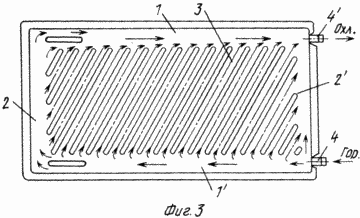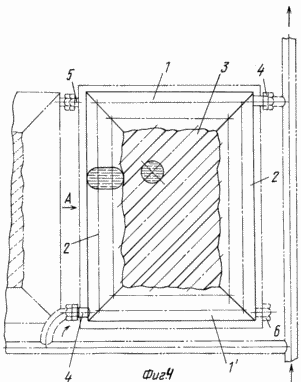| section Home
Production, Amateur Radio amateur Model aircraft, rocket- Useful, entertaining |
Stealth master
Electronics Physics Technologies invention |
space Mystery
Earth Mysteries Secrets of the Ocean Stealth section Map |
|
| Use of material is permitted for reference (for websites - hyperlinks) | |||
Navigation: => |
Home / Products Patents / In the section of the catalog / back / |
|
INVENTION
Russian Federation Patent RU2154241
![]()
radiators
Name of the inventor: Pobegalov Sergey
The name of the patentee: Pobegalov Sergey
Address for correspondence: 656049, Barnaul, pr. Krasnoarmeysky 57 kv.128, Pobegalovu SA
Starting date of the patent: 1998.09.25
The device is intended for use in heating, namely, water heating, refrigeration and others. The heating radiator includes sections formed from forged halves connected together to form a circulation channel and the feed and outlet headers with the appropriate a connector pipes, and sewers and circulating channels form when welding stamped halves which are themselves made inclined channels, each supply manifold section has a cone shape, and the output - confuser radiator section connected in series or in pairs to form a multiplicity of blocks 1,2,3 or more. The device reduces the flow resistance of the heating radiator.
DESCRIPTION OF THE INVENTION
The invention relates to heating technology, namely the system of water heating, refrigeration, and others.
A method for manufacturing a radiator element comprising a radiator element which consists of sections formed stamped halves connected together to form circulation channels and inlet and outlet manifold for connection to a respective nozzles (SU 43140 A, 31.5.1935).
The disadvantage of this radiator can be considered a high flow resistance, which reduces the heating capacity of the heating appliance.
The object of the invention is to reduce the flow resistance.
This object is achieved in the heating radiator consisting of the sections formed by stamped halves and interconnected to form a circulation channel, and the inlet and outlet headers with appropriate for connection to nozzles according to the invention the collectors and circulation channels form when welding stamped halves, wherein the channels are inclined supplying manifold each, the sections has a cone shape, and the output - confuser radiator section connected in series or in pairs to form units multiplicity 1, 2, 3 or more, connected to the heating system via diagonally arranged play connection pipes, wherein the radiator is not longer than it height.
BRIEF DESCRIPTION graphic materials.
 |
 |
 |
 |
FIG. 1 shows a heating radiator in longitudinal section;
FIG. 2 - form A (Figure 1.);
FIG. 3 - elongated heating radiator;
FIG. 4 - the heating radiator with oval sloping channels.
The heating radiator consists of horizontal and vertical headers 1, 2, 3 and 1 1 and 1 2, 3 and oblique channels for connection to the pipes 4, 4 1. When door-clutch unit radiators can be equipped with additional nozzles 5 and 6 plugs (see. Circuit).
Heating radiator works as follows.
Hot water from the riser heating systems, such as multi-storey building, through the lower diagonal tube 4 enters the collector 1 1, 2, oblique channels 3, manifolds 2, 1, partially cooled in a short diagonal path through the nozzle 4 1 returns to the riser storey lift.
The compact design provides rigidity and durability of the radiator. In the production of the proposed heating radiator no need to use multiple dies, presses and welding machines.
In an embodiment, the elongated heating radiator (see Fig. 3) suggests that circulating channels formed with a smaller inclination ~ 60 o, proximal provide upward flow and rigidity, while the pressure in the discharge diffuser expansion of the radiator lead to equalize the heating temperature field ie It would exclude the possibility of overflow of the shortest path from the nozzle to the nozzle 4 4 1.
In an embodiment, the heating radiator with oval inclined channels (see. Fig. 4) is expected to create high-pressure design, applicable for the first floors of high-rise buildings, where the stamped sheet cylinders radiators podverzhdeno the pump pressure and back pressure from below from above.
CLAIM
The heating radiator consisting of the sections formed by stamped halves and joined together to form circulation channels and inlet and outlet headers with corresponding a connector pipes, characterized in that the collector and the circulation channels form when welding stamped halves, with channels themselves are inclined, the feed each manifold section has a cone shape, and the output - confuser radiator section connected in series or in pairs to form a multiplicity of blocks 1, 2, 3 or more, connected to the heating system through diagonally arranged tubes play connection, wherein the radiator is not longer than its height.
print version
Publication date 24.01.2007gg




Comments
Commenting, keep in mind that the content and the tone of your messages can hurt the feelings of real people, show respect and tolerance to his interlocutors, even if you do not share their opinion, your behavior in terms of freedom of speech and anonymity offered by the Internet, is changing not only virtual, but real world. All comments are hidden from the index, spam control.